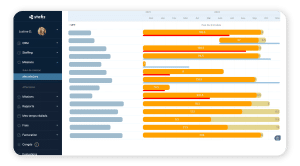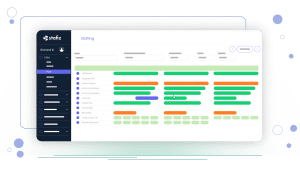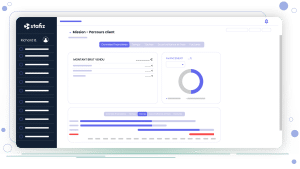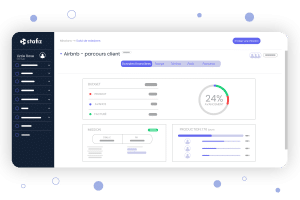How to choose the best project management software?

When a company is looking for project management software, they will find various alternatives in the market. How do you choose between all these project management tools? Which tool is most appropriate in each case?
In any company, the execution of projects must be done as quickly and economically as possible. To do this, there is a series of Key Performance Indicators (KPIs) that we cannot lose sight of, and a series of tasks to be carried out that will guarantee their execution in time and form.
The best project manager will be the one who responds to the selected KPIs, processes them and provides the most appropriate features to each company's objectives, priorities and values.
What is a project management tool and what is its function?
A project management tool is a planning tool that helps organize and optimize resources in order to execute a task plan with the best possible results.

Its main function is to ensure that the actions of a project are carried out as efficiently as possible according to the objectives set.
Let's say a company intends to implement a new cloud computing system on which the applications used by its employees will run. The organization has set the following goals for this project:
- Implement the new solution within six months.
- Maintain the current system until the new system is implemented.
- Avoid overtime in the development team and the IT team, in order to control salary costs during the process.
- Maintain a good working atmosphere in the department, by distributing the workloads derived from this new project fairly.
In this case, the role of the project manager will be to organize all the tasks and processes so that the action is executed in less than six months. This will help distribute workloads evenly, control overtime costs, and monitor the working environment in the department.
What are the criteria for choosing project management software?
When choosing such software, the company must therefore pay attention to:
- The KPIs it needs to measure.
- The tasks and features that will be managed from the management program.
Depending on the KPIs and the company's priority tasks, one tool or another will be more appropriate. All of them try to cover most of them. But a rigorous analysis leads us to conclude that some tools are more suitable than others, depending on the company's objectives.
For example, if accounting and resource planning are crucial for the business, Stafiz would be the best choice. But if we are trying to organize projects related to ticketing systems (a common operation in IT departments), it will be more appropriate to use managers such as Jira and, more specifically, its Bug Tracking model.
1. Project management KPIs to track
Below, we'll break down several KPIs that can be relevant in project management. Not all companies need to track them all exhaustively. It all depends on the objectives and values that are prioritized in each case.
Four main groups of KPIs
This is data that is closely monitored because it is an indicator of good or bad performance in a given element of the process.
In the case of project management, indicators can be grouped into four main groups that are fundamental to effective project planning:
- accounting/finance,
- personnel management,
- productivity and efficiency,
- organization.
Learn more about KPIs for project management.
Accounting and finance KPIs
At Stafiz, we believe that knowing how to implement project accounting is the basis of effective project monitoring. When it is well implemented, it allows project managers and directors to use management control techniques such as a finance team could do, but this time on a daily basis, throughout the project. If the company manages many projects and customers, it will need to move towards project portfolio management software. This will allow them to be compared in order to identify the most interesting projects or customers as well as the best practices to implement across the portfolio.
| KPIS | Definition | Purpose / Utility |
|---|---|---|
| Completion rate | The ratio of the theoretical time a project needs to the time it actually takes. | Measure actual performance against the planned budget. |
| Non-Billed Production | The production carried out (either in value or in time) that has not yet been invoiced to the customer. | Useful for better cash management. |
| Sales pipeline | Sales opportunities detected but not closed. | Forecast sales and anticipate the resources needed to cover them. |
| Actual vs. Expected Revenue | Calculation of revenue based on the completed portion of the project (percentage of completion). | Recognize revenues based on the percentage of the project completed. Allows you to economically quantify the time invested in the project and its profitability. |
To learn more, check out our in-depth article on the 12 project financial metrics to keep an eye on when managing your project.
People Management KPIs
| KPIS | Definition | Purpose / Utility |
|---|---|---|
| Time Control | Tracking the hours stipulated in each employee's employment contract. | Consider the hours set out in the contract to optimize workload appropriately. It is also a legal obligation for all companies. |
| utilization rate (billable utilization rate) | A percentage that determines the amount of time spent on billable projects in relation to the employee's total working time (excluding vacation periods). | Ensure that the work of the teams is cost-effective. |
| Staff Rates | Same as above, but including the total time spent (both billable projects and other activities, e.g. internal projects). | Control global workloads. |
| External staff costs | In good project management, the production capacity, utilization rate, and costs of external personnel must also be measured. | Adjust workloads and workflows more efficiently, using external resources, which can be a great help in achieving goals and better managing staff. |
| Turnover rate | Number of people leaving their jobs by moving to another company. | Alert on possible malfunctions in the work methodology that are not necessarily an incentive for workers. Their departure generates an increase in the cost of labour and a loss of productivity. |
| Vacation and Leave | Employee absences | Quantify the economic and productivity impact that the absence of a certain profile has on a project. And to be able to reorganize resources and compensate for them, if necessary. |
| Feedback | This is qualitative information that can nevertheless be very useful for decision-making. | Improve the efficiency of the processes and tasks that are part of a project. If, during feedback sessions, a high percentage of employees reveal the ineffectiveness of a certain software, we will have accurate information that will help us evaluate the cost of replacing it, the impact on productivity, etc. |
Productivity and efficiency
| KPIS | Definition | Purpose / Utility |
|---|---|---|
| Production Capacity | It measures the time spent on a project and is multiplied by the value of a day's work. | It allows you to know if the company can take on more projects, and at what level. If a company has ten developers, with a work value of €700 and working 240 days a year, it will have a production capacity of €1,680,000. It should look for contracts of at least equal value. |
| Potential productivity | Number of hours that, a priori, are necessary to carry out an action, segmented by type of job or function profile. | Estimate the number of hours (and their cost) that will be required to undertake a given task on a project. |
| Real productivity | The real-time required to carry out an action, segmented by type of professional profile or position. | It is compared to the previous figure to assess the actual profitability of a project in terms of the difference between potential and actual productivity. |
Organization
| KPIS | Definition | Purpose / Utility |
|---|---|---|
| Communication | Number of meetings and time spent on communication actions. May include time spent on Slack, email, or other similar apps. | Know how much time a given profile spends on this issue, in order to allocate it to projects appropriately. Qualitatively, it is interesting to extract information from employee feedback, to corroborate that this time spent is of real use for greater efficiency of processes. |
| Tasks | Number of actions that must be carried out to properly implement a project. | Estimating the time a task will take, the number of employees needed, the time each of them will have to invest, the duration of a project... |
| Projects | Number of projects in progress and their evolution. | Knowing how many projects are being carried out in parallel, what resources they consume, what the expected turnover will be... |
2. Tasks & Features of Project Management Software
Depending on the KPIs and objectives chosen, companies should prioritize project management tools that have the features to achieve them.
A simple but easy to understand example: let's imagine that a company has enough manpower to carry out five projects in parallel, so it sets itself the goal of managing this number of projects. But the selected project manager limits the number of projects on their platform to a maximum of two. This company will not be able to use this tool. On the other hand, it will be suitable for a freelancer working for a single company.
Therefore, the second metric to look at is: what is more important to achieve the goals and track the set KPIs? Or, in other words, which features and tasks are prioritized for the business in project management? Some of the most relevant include:
- Planning and task management.
- Resource planning.
- Communication.
- Project reporting (BI)
- Ticket management.
- Budget monitoring.
- Project documentation.
1. Planning and task management
This is a very important feature in project management, as it allows us to visualize the overall status of tasks, workloads, estimated execution times, and more. in a fast and agile way. The two most common representations are the Gantt chart and Kanban.
- The Gantt chart is an online chart system that represents the tasks that need to be performed to complete a project. In addition to the interrelationship with the other tasks, the time allocated to each task and the person responsible for each task. So, if a task falls behind, tasks that depend on it will have to start later. Compared to the originally planned schedule, it allows us to quickly see if the project is on schedule or behind schedule. It is also possible to know if there is a need to reallocate resources, change workloads, or make time adjustments.

- Kanban is another planning methodology that, in this case, is represented by columns. Each column is associated with a status, for example: "In progress", "In progress", "Completed"
This proposal is just one example. In project managers that integrate Kanban templates, tasks can be easily organized and notes such as priority, responsible person, estimated completion date, dependent tasks, etc. can be added. In this way, the project manager can check progress at a glance and make decisions about the organization of tasks.
2. Resource Planning and Allocation (resource planning)
Resource planning is the process of assessing resource requirements and aligning appropriate resources with them, like a game of supply and demand: this is resource capacity planning. The aim of this phase is to provide the company with adequate human resources capacity to deliver present and future projects with the expected level of quality. In concrete terms, for the process to be effective, the tool must integrate profile and skills management functions: sourcing, labeling and organizing profile requests.
Resource allocation and the link according to the planning. The aim is to allocate the resources present to projects and to optimise the utilization rate (billable utilization rate) while satisfying employees. To do this, the tool will have to integrate scheduling, simplified manual or automatic allocation functions. The interface should be intuitive with drag and drop if possible to facilitate modifications.

A project manager who contributes to a good allocation of resources will facilitate a correct distribution of workloads, avoiding inequalities that can affect the working environment.
With the right project management tool, the company can quickly visualize the status of the project against the expected completion date. If employees are performing well, but not meeting deadlines, the company will have a red flag that will invite it to analyze whether the technical resources are the most appropriate, for example.
3. Communication
Smooth and quality communication is another fundamental aspect. The communication skills of the leader, manager or project manager are essential. But having the necessary tools to make this communication truly effective and efficient is required.
Because in good project management, communication must be sufficient but not excessive. Excessive communication, too many meetings, or unproductive follow-up sessions can be detrimental to projects, which is why they should also be controlled.
4. Project reporting (BI)
Project reporting (BI) is essential especially for service activities because it provides a real-time view of the status of a project and understands the origin of problems.

It is also essential to have features that can corroborate the cost of this time, depending on the human and technical resources invested. Because, in this way, the company obtains valuable information to optimize budgets and projects in the most cost-effective way possible.
5. Ticket management
This feature group is important if your project is software development oriented and therefore has bugs or features to be developed. This type of software often includes repositories. These tools comply with the so-called agile development methodologies (scrum, etc.)
6. Staying on budget
Staying on budget is key, and a good project management tool should help control, organize, and optimize costs.

In order to complete the project, project managers will need quick access to operational expenses, costs derived from external resources, contracts with partners, purchasing, license acquisition, etc. All of these must be updated at the time queries are made. Indeed, the closer the budget monitoring is to reality in terms of time and value, the better the orientations and adjustments will be on the project.
It is also important to have a forecast of what these costs will be at the end of the project, depending on the type of task to be executed, the execution time, whether or not more resources are needed... And always in comparison with the initial budget allocated to the project.
7. Document the project
Project documentation is the key to transparent and secure project management. It is a criterion that is often not given the attention it deserves. Yet, it is crucial for two reasons:
- For the project itself. Sometimes it is necessary to review a certain step that was taken several months ago, but which is essential to solve a problem that is currently arising. It is therefore particularly relevant in projects with interrelated tasks. If one does not properly document the project, one risks wasting a lot of time and money trying to find a solution to a problem that arises from the way a certain issue has been handled in the past.
- As a reference for future projects. Sometimes, project managers are faced with circumstances that other teams, or themselves, have faced in the past. Proper documentation will speed up the decision-making process and increase the profitability of future projects.
Other functions that are also relevant to the selection of a project manager
In some projects, it is necessary to pool the work of several departments. A solution with high user-friendliness, which allows easy implementation and can be used simultaneously and in real time by several users, will be the key to facilitating interdepartmental relationships.
Another important aspect is that the project management tool has a good support service and easy integration with other programs. The more information the company has, the better the strategic decisions will be. In addition, centralizing all processes on one platform is a great way to save time and, as a result, make projects an even more cost-effective and efficient process.
And, of course, the price of the solution itself will be another point that the company will need to analyze before making a final decision on which project management system is best for them.
To go further, find out what the best project management software by category is in our in-depth article.
Conclusion
First, companies need to determine which KPIs they want to track. Only then do they need to identify which project management software incorporates the most appropriate features and tasks to achieve them, without losing sight of a whole series of global recommendations that allow them to meet the objectives of project duration and profitability. This may include, for example, proper planning, comprehensive follow-up or realistic, data-driven post-project analysis. These are issues for which project management software becomes a fundamental ally, capable of accelerating and optimizing work management and, therefore, stimulating the growth of the company.

